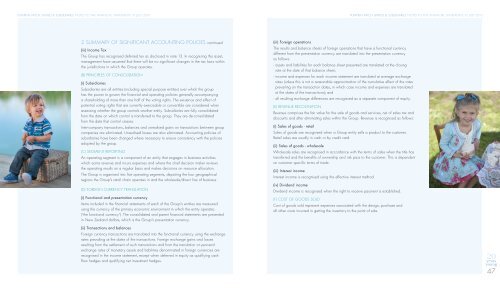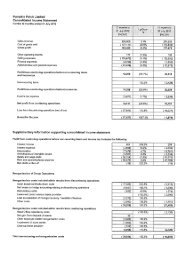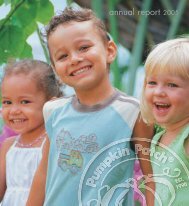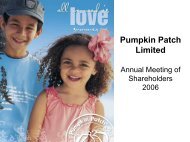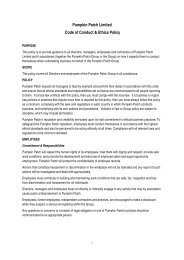Group Financial Statements/Auditors' Report - Pumpkin Patch ...
Group Financial Statements/Auditors' Report - Pumpkin Patch ...
Group Financial Statements/Auditors' Report - Pumpkin Patch ...
You also want an ePaper? Increase the reach of your titles
YUMPU automatically turns print PDFs into web optimized ePapers that Google loves.
PUMPKIN PATCH LIMITED & SUBSIDIARIES NOTES TO THE FINANCIAL STATEMENTS 31 JULY 2010<br />
PUMPKIN PATCH LIMITED & SUBSIDIARIES NOTES TO THE FINANCIAL STATEMENTS 31 JULY 2010<br />
2 SUMMARY OF SIGNIFICANT ACCOUNTING POLICIES continued<br />
(iii) Income Tax<br />
The <strong>Group</strong> has recognised deferred tax as disclosed in note 13. In recognising this asset,<br />
management have assumed that there will be no significant changes in the tax laws within<br />
the jurisdictions in which the <strong>Group</strong> operates.<br />
(B) PRINCIPLES OF CONSOLIDATION<br />
(i) Subsidiaries<br />
Subsidiaries are all entities (including special purpose entities) over which the group<br />
has the power to govern the financial and operating policies generally accompanying<br />
a shareholding of more than one half of the voting rights. The existence and effect of<br />
potential voting rights that are currently exercisable or convertible are considered when<br />
assessing whether the group controls another entity. Subsidiaries are fully consolidated<br />
from the date on which control is transferred to the group. They are de‐consolidated<br />
from the date that control ceases.<br />
Inter‐company transactions, balances and unrealised gains on transactions between group<br />
companies are eliminated. Unrealised losses are also eliminated. Accounting policies of<br />
subsidiaries have been changed where necessary to ensure consistency with the policies<br />
adopted by the group.<br />
(C) SEGMENT REPORTING<br />
An operating segment is a component of an entity that engages in business activities<br />
which earns revenue and incurs expenses and where the chief decision maker reviews<br />
the operating results on a regular basis and makes decisions on resource allocation.<br />
The <strong>Group</strong> is organised into five operating segments, depicting the four geographical<br />
regions the <strong>Group</strong>’s retail chain operates in and the wholesale/direct line of business.<br />
(D) FOREIGN CURRENCY TRANSLATION<br />
(i) Functional and presentation currency<br />
Items included in the financial statements of each of the <strong>Group</strong>’s entities are measured<br />
using the currency of the primary economic environment in which the entity operates<br />
(‘the functional currency’). The consolidated and parent financial statements are presented<br />
in New Zealand dollars, which is the <strong>Group</strong>’s presentation currency.<br />
(iii) Foreign operations<br />
The results and balance sheets of foreign operations that have a functional currency<br />
different from the presentation currency are translated into the presentation currency<br />
as follows:<br />
- assets and liabilities for each balance sheet presented are translated at the closing<br />
rate at the date of that balance sheet;<br />
- income and expenses for each income statement are translated at average exchange<br />
rates (unless this is not a reasonable approximation of the cumulative effect of the rates<br />
prevailing on the transaction dates, in which case income and expenses are translated<br />
at the dates of the transactions); and<br />
- all resulting exchange differences are recognised as a separate component of equity.<br />
(E) REVENUE RECOGNITION<br />
Revenue comprises the fair value for the sale of goods and services, net of sales tax and<br />
discounts and after eliminating sales within the <strong>Group</strong>. Revenue is recognised as follows:<br />
(i) Sales of goods ‐ retail<br />
Sales of goods are recognised when a <strong>Group</strong> entity sells a product to the customer.<br />
Retail sales are usually in cash or by credit card.<br />
(ii) Sales of goods ‐ wholesale<br />
Wholesale sales are recognised in accordance with the terms of sales when the title has<br />
transferred and the benefits of ownership and risk pass to the customer. This is dependent<br />
on customer specific terms of trade.<br />
(iii) Interest income<br />
Interest income is recognised using the effective interest method.<br />
(iv) Dividend income<br />
Dividend income is recognised when the right to receive payment is established.<br />
(F) COST OF GOODS SOLD<br />
Cost of goods sold represent expenses associated with the design, purchase and<br />
all other costs incurred in getting the inventory to the point of sale.<br />
(ii) Transactions and balances<br />
Foreign currency transactions are translated into the functional currency using the exchange<br />
rates prevailing at the dates of the transactions. Foreign exchange gains and losses<br />
resulting from the settlement of such transactions and from the translation at year‐end<br />
exchange rates of monetary assets and liabilities denominated in foreign currencies are<br />
recognised in the income statement, except when deferred in equity as qualifying cash<br />
flow hedges and qualifying net investment hedges.<br />
20<br />
years<br />
young<br />
47


